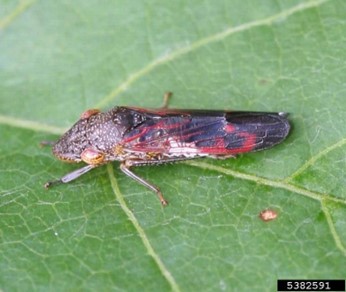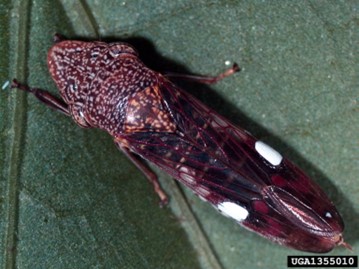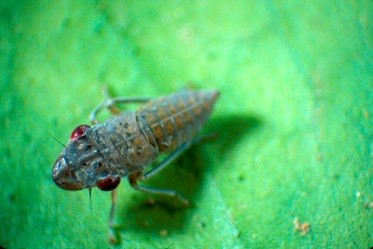Glassy-winged sharpshooter
An exotic pest – not wanted in Australia
Glassy-winged sharpshooter (Homalodisca vitripennis) is a large leafhopper that is a major threat to Australia’s viticulture, citrus, stonefruit, tree nut and nursery production industries.
It is known to transmit the disease-causing bacterium Xylella fastidiosa, which is also a national priority biosecurity concern.
Keeping glassy-winged sharpshooter out of the country is a national priority.
Have you seen this pest?
- Adults are about 11 to 14 mm long (Figures 1 and 2) with a large flat head and protruding eyes. The transparent wings have distinctive red-coloured veins.
- Adults and juveniles suck sap from wild and cultivated plants.
- Sap sucking results in large amounts of fluid being excreted onto fruit and leaves, giving affected surfaces a whitewashed appearance.

What should I do?
- Report immediately.
- Share your photos with us using the Online Public Reporting Form OR
- Call the Exotic Plant Pest Hotline 1800 084 881.
- Please take good quality photos of the pest and/or damage to include in your report. For tips see the How to take good photos for a report guide.
Why is it a pest of concern?
- Glassy-winged sharpshooter is an exotic sap-sucking pest of hundreds of economically important crop species and nursery ornamentals.
- If it were to arrive in Australia, many native species would also be susceptible.
- Symptoms can include signs of water stress, such as leaf wilting, yellowing and loss, as well as stunted growth. This is especially evident in large infestations.
- Glassy-winged sharpshooter can transmit the disease-causing bacterium Xylella fastidiosa, which can cause water stress symptoms, leaf scorch, dieback, yellowing leaves, reduced fruit size, progressive weakening of the plant and eventual plant death.
- It is difficult to distinguish the symptoms of glassy-winged sharpshooter and Xylella.
Where to look
- Adults can be found feeding on woody plant tissues such as stems, trunks, branches and leaf petioles.
- The sap-sucking feeding results in the excretion of copious quantities of clear liquid known as ‘leafhopper rain.’ This dries to a powdery white residue on affected surfaces, giving a whitewashed appearance to trees, cars and other infrastructure.
- Clutches of around 8 to 12 elongated eggs (but sometimes up to 28) are laid under the surface of the underside of leaves, or sometimes on stems or fruit such as on citrus rind.
Pest profile
Appearance
- Adults: Mature males measure 11–13 mm long; mature females are slightly larger at 12–14 mm. All adults have a large flat head and protruding eyes. The head and back are dark brown to black, with stippled ivory yellow spots. The transparent wings have distinctive red veins. Females excrete a chalky white patch on each wing before laying eggs, which is used to cover the egg masses (Figure 2).
- Juveniles (nymphs): Smaller versions of the adult but lacking fully developed wings and are dark grey in colour (Figure 3).
- Eggs: Clutches of eggs laid under the leaf surface look blister-like. When the eggs hatch, the leaf tissue dies, leaving a permanent brown scar (Figures 4 and 5).



Host plants in Australia
- Glassy-winged sharpshooter is a stem feeder on over 300 species of crop and ornamental plants.
- Crop plant hosts include blueberries, almonds, cherries, citrus, coffee, grapes, peaches, plums, macadamias and pistachios.
- Ornamentals such as Bougainvillea, Camellia, crepe myrtles and Chrysanthemum are also affected.
- Susceptible natives include acacias, kangaroo paw, bottle tree, flax lilies, native frangipani, grevilleas, tea-tree and Wollemi pines.
Life cycle
- Eggs are laid in late winter or early spring.
- Juveniles hatch in 10 to 14 days and progress through 5 juvenile stages before reaching adulthood.
- Adults live for approximately 2 months and can lay eggs during summertime – generally, there are 2 generations per year, but in warmer climates that number might be higher.
Distribution and dispersal
- Native to south-eastern United States, it has spread to western US, Mexico, Chile, French Polynesia, Hawaii, Easter Island and the Cook Islands.
- Glassy-winged sharpshooter adults are strong fliers and will move readily from plant to plant. Juveniles will walk or jump between nearby plants.
- Long-distance spread occurs primarily from human-assisted movement of nursery stock and host plant material infested with eggs, juveniles or adults.
Image credits
Figure 1: Johnny N Dell, bugwood.org
Figure 2: Reyes Garcia III, USDA Agricultural Research Service, bugwood.org
Figure 3: Phil A Phillips, Ventura County Agriculture, University of California Agriculture and Natural Resources, used with permission.
Figure 4: Ken Peek, Alameda County Department of Agriculture, used with permission.
Reporting an unusual plant insect pest or disease
Report any unusual plant pest or disease immediately using our online reporting form or by calling the Exotic Plant Pest Hotline on 1800 084 881. Early reporting increases the chance of effective control and eradication.
Please take multiple good quality photos of the pests or damage to include in your report where possible, as this is essential for rapid pest and disease diagnosis and response.
Your report will be responded to by an experienced staff member, who may seek more information about the detection and explain next steps.
Report online